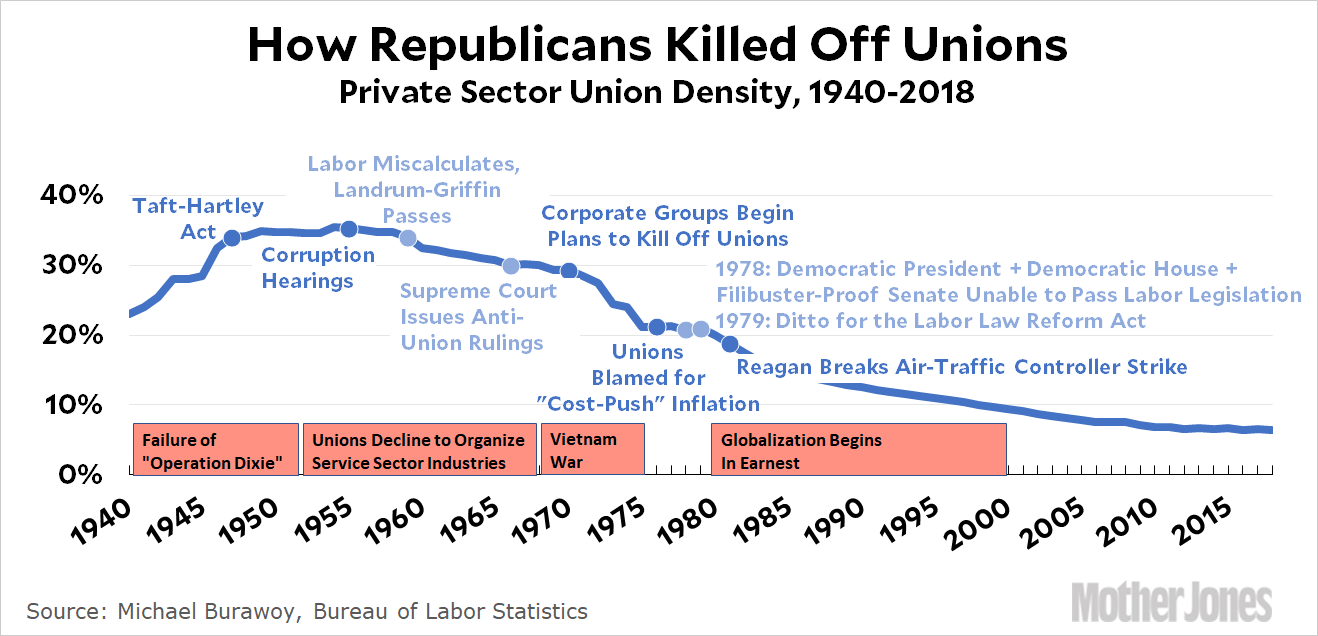Have American businesses become more concentrated over the past 30 years? Anecdotally, it seems like the answer is yes. The Big 8 accounting firms are now the Big 4. There are only four cell phone companies, soon to be three. Four airlines control 80 percent of the American market. The car industry consolidated into the Big Three decades ago. Four companies control two-thirds of the cloud computing market.
But in spite of this anecdotal feeling, it’s an undecided question among economists about whether American businesses are really a lot more concentrated than they used to be. Anyone can pick a few examples of industries that have consolidated, but what happens when you look rigorously at the business community overall?
We’re not going to solve this question today, though in general I’ve been more persuaded by the researchers who say that consolidation has, in fact, happened, and the result has been increasingly monopolistic behavior among US corporations.
One of those researchers is French transplant Thomas Philippon, who is introduced to us today in the New York Times by David Leonhardt. Philippon’s research has convinced him that we have indeed gone through an era of considerable consolidation, and it’s mainly due to weak enforcement of antitrust laws. In Europe, which has much stronger antitrust enforcement than we do, Philippon reports that the top firms have increased their market share far less than American firms. As a result, prices charged to consumers have also increased far less than in America. Here is Philippon’s conclusion about how this has affected American workers:
The consolidation of corporate America has become severe enough to have macroeconomic effects. Profits have surged, and wages have stagnated. Investment in new factories and products has also stagnated, because many companies don’t need to innovate to keep profits high. Philippon estimates that the new era of oligopoly costs the typical American household more than $5,000 a year.
I find that $5,000 number quite easy to believe. In fact, it seems a little low to me. But how did it happen? Even with weak antitrust enforcement (thanks Robert Bork!), how do companies get away with raising prices and cutting pay? They still have some competition, after all. The answer to that, I think, is the long Republican war against unions:

The destruction of the American working class is a two-part story. First, it was necessary to get rid of unions. As long as they were around, they’d demand a fair share of profits for workers no matter what the competition landscape looked like. That war lasted from about 1947 to 1981. When Ronald Reagan broke the air-traffic controllers union it was the final straw. Unions had already been decimated both by Republican laws and by Republican-led-efforts to train companies in how to resist unionization. Democrats never had the will to fight back hard enough, and after Reagan they never had the power. Republicans won their war against unions decisively.
It was only then, with unions effectively out of the way, that corporations could start consolidating and taking an ever bigger share of profits for top executives and shareholders, leaving workers with stagnating wages and grinding working conditions. No union, for example, would accept the practice of “clopening,” where an employee is required to close up a store at night and then turn right around and open in the morning. Nor would they accept the ever-more-common practice of expecting workers to be on call at all times, never knowing for sure what their work schedule will be. As much as low pay, these are the kinds of things that make work such a burden for the working class these days.
So this is the story. Spend three or four decades wiping out the power of labor unions, and then you can spend the next three or four decades turning the United States into a plutocracy with no one to effectively fight you about it.
And you have to give Republicans credit: Not only did they cobble together this plan and execute it brilliantly, they’ve managed even so to convince much of the working class that only Republicans truly understand their economic woes. They’re the very party that created those woes by killing off unions and then letting corporate America loose to do whatever it wanted, but hardly anyone sees it that way. Donald Trump yells “China” or “Mexico” and the working class howls its approval. I guess it must be China and Mexico that caused all these problems after all.


















